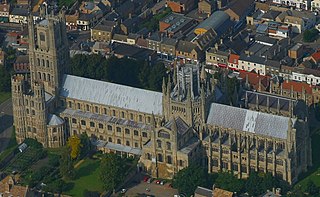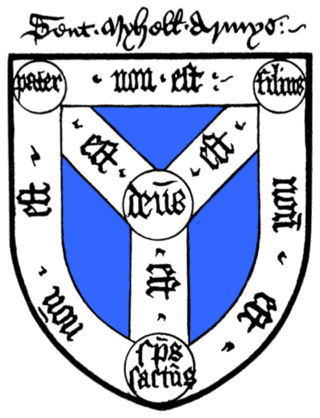Related Research Articles
Celibacy is the state of voluntarily being unmarried, sexually abstinent, or both, usually for religious reasons. It is often in association with the role of a religious official or devotee. In its narrow sense, the term celibacy is applied only to those for whom the unmarried state is the result of a sacred vow, act of renunciation, or religious conviction. In a wider sense, it is commonly understood to only mean abstinence from sexual activity.
Pope Alexander II, born Anselm of Baggio, was the head of the Roman Catholic Church and ruler of the Papal States from 1061 to his death in 1073. Born in Milan, Anselm was deeply involved in the Pataria reform movement. Elected according to the terms of his predecessor's bull, In nomine Domini, Anselm's was the first election by the cardinals without the participation of the people and minor clergy of Rome. He also authorized the Norman Conquest of England in 1066.

Lanfranc, OSB was a celebrated Italian jurist who renounced his career to become a Benedictine monk at Bec in Normandy. He served successively as prior of Bec Abbey and abbot of St Stephen's Abbey in Caen, Normandy and then as Archbishop of Canterbury in England, following its conquest by William the Conqueror. He is also variously known as Lanfranc of Pavia, Lanfranc of Bec, and Lanfranc of Canterbury. In his lifetime, he was regarded as the greatest theologian of his generation.
Ralph d'Escures was a medieval abbot of Séez, bishop of Rochester, and then archbishop of Canterbury. He studied at the school at the Abbey of Bec. In 1079 he entered the abbey of St Martin at Séez and became abbot there in 1091. He was a friend of both Archbishop Anselm of Canterbury and Bishop Gundulf of Rochester, whose see, or bishopric, he took over on Gundulf's death.
Clerical celibacy is the requirement in certain religions that some or all members of the clergy be unmarried. Clerical celibacy also requires abstention from deliberately indulging in sexual thoughts and behavior outside of marriage, because these impulses are regarded as sinful. Vows of celibacy are generally required for monks and nuns in Christianity, Buddhism, Hinduism, Jainism and other religions, but often not for other clergy.

Fulk IV, better known as Fulk le Réchin, was the count of Anjou from around 1068 until his death. He was noted to be "a man with many reprehensible, even scandalous, habits" by Orderic Vitalis, who particularly objected to his many women and his influential footwear, claiming he popularized the pigaches that eventually became the poulaine, the medieval long-toed shoe.
Gerard was Archbishop of York between 1100 and 1108 and Lord Chancellor of England from 1085 until 1092. A Norman, he was a member of the cathedral clergy at Rouen before becoming a royal clerk under King William I of England and subsequently his son King William II Rufus. Gerard was appointed Lord Chancellor by William I, and he continued in that office under Rufus, who rewarded him with the Bishopric of Hereford in 1096. Gerard may have been with the king's hunting party when William II was killed, as he is known to have witnessed the first charter issued by the new king, Henry I of England, within days of William's death.

The Synod of Elvira was an ecclesiastical synod held at Elvira in the Roman province of Hispania Baetica, now Granada in southern Spain. Its date has not been exactly determined but is believed to be in the first quarter of the fourth century, approximately 305–6. It was one of three councils, together with the Synod of Arles (314) and the Synod of Ancyra, that first approached the character of general councils and prepared the way for the first ecumenical council. It was attended by nineteen bishops and twenty-six presbyters, mostly resident in Baetica. Deacons and laymen were also present. Eighty-one canons are recorded, although it is believed that many were added at later dates. All concern order, discipline and conduct among the Christian community. Canon 36, forbidding the use of images in churches, became a bone of contention between Catholic and Protestant scholars after the Protestant Reformation.
Robert Bloet was Bishop of Lincoln 1093–1123 and Chancellor of England. Born into a noble Norman family, he became a royal clerk under King William I. Under William I's son and successor King William II, Bloet was first named chancellor then appointed to the See of Lincoln. Continuing to serve the king while bishop, Bloet remained a close royal councillor to William II's successor, King Henry I. He did much to embellish Lincoln Cathedral, and gave generously to his cathedral and other religious houses. He educated a number of noblemen, including illegitimate children of Henry I. He also was the patron of the medieval chronicler Henry of Huntingdon, and was an early patron of Gilbert of Sempringham, the founder of the Gilbertine monastic order.

Thomas of Bayeux was Archbishop of York from 1070 until 1100. He was educated at Liège and became a royal chaplain to Duke William of Normandy, who later became King William I of England. After the Norman Conquest, the king nominated Thomas to succeed Ealdred as Archbishop of York. After Thomas' election, Lanfranc, Archbishop of Canterbury, demanded an oath from Thomas to obey him and any future Archbishops of Canterbury; this was part of Lanfranc's claim that Canterbury was the primary bishopric, and its holder the head of the English Church. Thomas countered that York had never made such an oath. As a result, Lanfranc refused to consecrate him. The King eventually persuaded Thomas to submit, but Thomas and Lanfranc continued to clash over ecclesiastical issues, including the primacy of Canterbury, which dioceses belonged to the province of York, and the question of how York's obedience to Canterbury would be expressed.

Hervey le Breton was a Breton cleric who became Bishop of Bangor in Wales and later Bishop of Ely in England. Appointed to Bangor by King William II of England, when the Normans were advancing into Wales, Hervey was unable to remain in his diocese when the Welsh began to drive the Normans back from their recent conquests. Hervey's behaviour towards the Welsh seems to have contributed to his expulsion from his see. Although the new king, Henry I wished to translate Hervey to the see of Lisieux in Normandy, it was unsuccessful.
William Warelwast was a medieval Norman cleric and Bishop of Exeter in England. Warelwast was a native of Normandy, but little is known about his background before 1087, when he appears as a royal clerk for King William II. Most of his royal service to William was as a diplomatic envoy, as he was heavily involved in the king's dispute with Anselm, the Archbishop of Canterbury, which constituted the English theatre of the Investiture Controversy. He went several times to Rome as an emissary to the papacy on business related to Anselm, one of whose supporters, the medieval chronicler Eadmer, alleged that Warelwast bribed the pope and the papal officials to secure favourable outcomes for King William.
John of Tours or John de Villula (died 1122) was a medieval Bishop of Wells in England who moved the diocese seat to Bath. He was a native of Tours and was King William I of England's doctor before becoming a bishop. After his consecration as bishop, he was either given or purchased Bath Abbey, a rich monastery, and then moved the headquarters of the diocese from Wells, to the abbey. He rebuilt the church at Bath, building a large cathedral that no longer survives. He gave a large library to his cathedral and received the right to hold a fair in Bath. Not noted for his scholarship, he died suddenly in 1122.
Robert de Limesey was a medieval cleric. He became Bishop of Chester in 1085, then his title changed to Bishop of Coventry when the see was moved in 1102.
Reynelm was a medieval Bishop of Hereford.

The Holy Trinity Priory, also known as Christchurch Aldgate, was a priory of Austin canons founded around 1108 by the English queen Matilda of Scotland near Aldgate in London.
Osana was a Northumbrian princess, whose local following as a saint developed informally after her death, though she was never officially canonised. Centuries after her death, she was described by the Norman-Welsh chronicler Giraldus Cambrensis as the sister of King Osred I of Northumbria, which would make her the daughter of King Aldfrith of Northumbria. Osana was depicted by Giraldus as inflicting a miraculous flagellation from her grave in Howden, Yorkshire, upon a concubine of the priest of the collegiate church there, a moral tale intended to inculcate clerical celibacy. Celibacy of the Anglo-Saxon clergy was not expected in Osana's time; when it began to be enforced from the top at even the higher levels, with Archbishop Anselm's council of London, 1102, it continued to be resisted in Britain, though it was a central objective of Gregorian reform.

Anselm of CanterburyOSB, also called Anselm of Aosta after his birthplace and Anselm of Bec after his monastery, was an Italian Benedictine monk, abbot, philosopher, and theologian of the Catholic Church, who served as Archbishop of Canterbury from 1093 to 1109.
The Canterbury–York dispute was a long-running conflict between the archdioceses of Canterbury and York in medieval England. It began shortly after the Norman Conquest of England and dragged on for many years. The main point of the dispute was over whether Canterbury would have jurisdiction, or primacy, over York. A number of archbishops of Canterbury attempted to secure professions of obedience from successive archbishops of York, but in the end they were unsuccessful. York fought the primacy by appealing to the kings of England as well as the papacy. In 1127, the dispute over the primacy was settled mainly in York's favour, for they did not have to submit to Canterbury. Later aspects of the dispute dealt with concerns over status and prestige.
Husband selling was the historical practice of: a wife selling a husband, generally to a new wife; an enslaver or enslaver's estate selling the husband in an enslaved family, generally to a new enslaver; court-sentenced sales of fathers' services for some years, described as sales of fathers ; sales of a husband as directed by a religious authority.
References
Citations
- ↑ Partner (1973), pp. 467–475, 468.
- ↑ Boswell (1981), p. 215.
- 1 2 Vaughn (1975), p. 295.
- ↑ Perry (1890), p. 190.
- ↑ Pijper (1909), p. 681.
- ↑ Crawley (1910).
- ↑ Thomas (2006), p. 35.
- ↑ Smith (1942).
Bibliography
- Boswell, John (1981), Christianity, Social Tolerance, and Homosexuality , Chicago: University of Chicago Press, ISBN 0-226-06711-4 .
- Crawley, John J. (1910), Lives of the Saints, John J. Crawley & Co., archived from the original on 11 May 2017, retrieved 29 June 2015
- Partner, Nancy (December 1973), "Henry of Huntingdon: Clerical Celibacy and the Writing of History", Church History, 42 (4): 467–475, 468, doi:10.2307/3164967, JSTOR 3164967, S2CID 162469275 .
- Perry, George Gresley (1890), A History of the English Church: First Period: From the Planting of the Church in Britain to the Accession of Henry VIII. (596–1509), The Student's English Church History (5th ed.), London: John Murray.
- Pijper, Frederik (1909), "The Christian Church and Slavery in the Middle Ages", The American Historical Review, Vol. XIV, No. 4, American Historical Association, JSTOR 1837055 .
- Smith, R.A.L. (1942), "John of Tours, Bishop of Bath 1088–1122", Downside Review, Vol. LXX, pp. 132–141.
- Thomas, Hugh (2006), The Slave Trade: History of the Atlantic Slave Trade, 1440-1870, Weidenfeld & Nicolson, ISBN 978-0753820568 .
- Vaughn, Sally (1975), "St Anselm of Canterbury: the Philosopher-Saint as Politician", Journal of Medieval History, Vol. I, pp. 279–306.